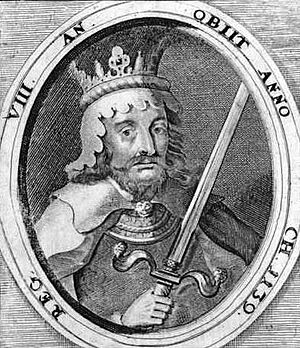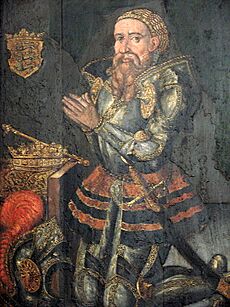Eric II of Denmark facts for kids
Quick facts for kids Eric II |
|
|---|---|
 |
|
| King of Denmark | |
| Reign | 25 June 1134 – 18 September 1137 |
| Predecessor | Niels |
| Successor | Eric III |
| Born | c. 1090 |
| Died | 18 September 1137 (aged 46–47) Urnehoved, Denmark |
| Burial | Ribe Cathedral |
| Spouse | Thunna (concubine) Malmfred of Kiev |
| Issue | Sweyn III of Denmark (ill.) |
| House | Estridsen |
| Father | Eric I of Denmark |
Eric II the Memorable (Danish: Erik II Emune; born around 1090 – died September 18, 1137) was the king of Denmark from 1134 to 1137. He was the son of an earlier Danish king, Eric I of Denmark. Eric the Memorable became king after a big fight against his uncle, Niels of Denmark. He was known for being very strict with those who opposed him and generous to his supporters. He died in 1137 and his nephew, Eric III of Denmark, became king after him.
Becoming King
Eric was born around 1090. His father was King Eric I of Denmark. Eric was given some Danish islands by his half-brother, Canute Lavard. He became a jarl (a type of noble leader) of Møn, Lolland, and Falster.
When Canute Lavard was murdered in 1131, Eric joined his other half-brother, Harald Kesja. They rebelled against the king, Niels of Denmark, who was responsible for the murder. Eric was chosen as a rival king, or Antiking, in Scania in April 1131. This made Harald Kesja jealous, so he then supported King Niels.
Eric's army lost several battles against Niels and his son, Magnus the Strong. These losses included battles at Jelling in Jutland in 1131 and Værbro on Zealand. Eric had to flee to Scania. Because of his quick escape, people nicknamed him Harefoot.
Eric tried to get help from other powerful rulers. He asked Lothair III, Holy Roman Emperor and Magnus IV of Norway for support, but they didn't help him at first. He returned to Scania in 1134. There, Archbishop Asser of Lund joined his side. Eventually, Emperor Lothair also decided to support Eric.
In 1134, Eric's army faced King Niels's army at the Battle of Fotevik in Scania. Eric won this battle with important help from German mercenaries (soldiers who fight for money). King Niels died later that year.
Ruling Denmark
After his big victory at Fotevik, Eric was declared king at a special assembly called a landsting in Scania, near Lund. Eric then made Lund his capital city. His nickname changed from Harefoot to the Memorable because of his great victory at Fotevik.
Harald Kesja, Eric's half-brother, tried to become king again in another part of Denmark. Eric chased him down and killed Harald Kesja and most of his sons. Only one son, Olaf Haraldsen, managed to escape.
A Strict Leader
King Eric wanted to make his rule strong and legitimate. He gave special titles and benefits to those who had supported him. He also made Eskil, the nephew of Archbishop Asser, the Bishop of Roskilde.
Eric was known for being very strict with his enemies. In the summer of 1136, he led a military campaign against the people living on the Baltic island of Rügen. Their capital was Arkona. Eric ordered his soldiers to dig a canal between the city and the rest of the island. This dried up the city's drinking water supply, forcing Arkona to surrender.
Before this success, in 1135, Eric won a naval battle near Denmark's coast. He defeated the West Slavic troops led by Pomeranian Duke Ratibor. These troops had previously attacked Roskilde. A year later, after a battle at Konungahela (now Kungälv in Sweden), Eric's forces also attacked that city. Eric also joined Magnus for a military trip to Norway, where he managed to burn down Oslo.
When Eric learned that Bishop Eskil had started a rebellion against him on Zealand, he quickly returned. The rebellion was spreading fast across Funen and Jutland. Eric put down the rebellion and made Eskil pay a large fine.
Religious Efforts
Eric also started the process of making his half-brother, Canute Lavard, a saint. This process is called canonization. He built an abbey (a type of monastery) at Ringsted to collect stories of miracles happening at Canute's grave. Eric wanted to show that his right to be king came from God. Making Canute a saint would help support his claim to the throne. Canute was finally made a saint in 1170.
His Final Days
King Eric was killed on September 18, 1137. He was a harsh and not very popular ruler. He died at the Urnehoved landsting assembly. A local nobleman named Sorte Plov killed him.
According to a legend, Sorte Plov asked to approach the king. He carried a spear with a wooden block covering its tip. Sorte Plov saw that King Eric was not wearing armor under his clothes. He then kicked off the wooden cover and pushed his spear right through the king.
King Eric's nephew, Erik Håkonssøn, stepped forward with his sword. But the nobleman told him to calm down. He said Erik Håkonssøn was next in line for the throne, as he was the only adult male in the royal family. The legend says Sorte Plov escaped and lived. Eric was buried at Ribe Cathedral. Erik Håkonssøn was then crowned Eric III of Denmark.
Family Life
Before 1130, Eric married Malmfred of Kiev. She was the daughter of Grand Duke Mstislav I of Kiev. Malmfrid had been married before to King Sigurd I of Norway. Eric also had a son named Sweyn with a partner named Thunna. This son, Sweyn, later became King Sweyn III of Denmark.


